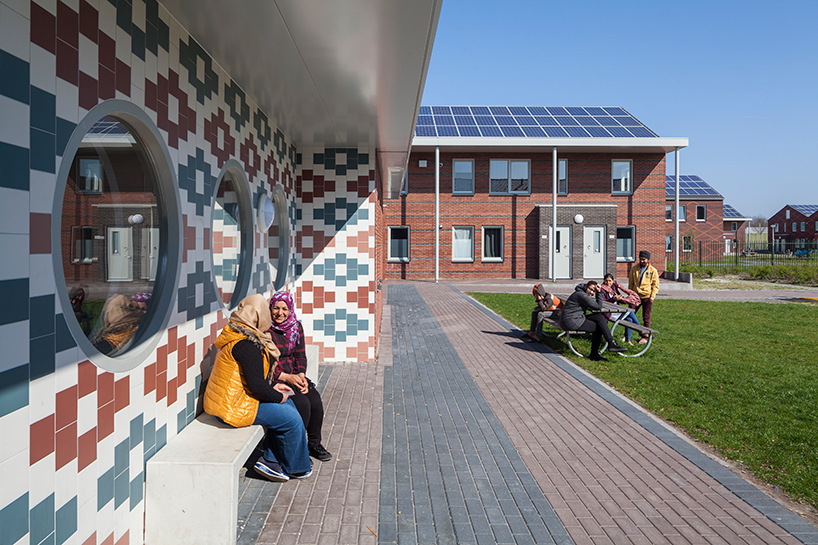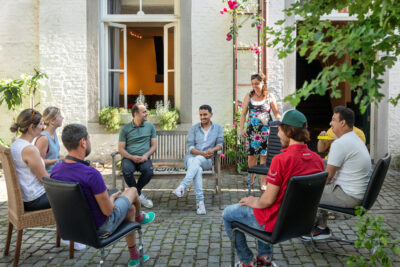

foto: Philip Driessen - Maastricht RPM - KeizerKarelplein 5, Safwan Abdulhamid en Sufian Jubran, Refugee Project Maastricht, taalcafé
By Áine Macdonald, RPM volunteer Project Voice
On Thursday 12th November, Refugee Project Maastricht hosted an interactive talk for all our volunteers about the journey that refugees must undergo to get to the Netherlands. The volunteers had an opportunity to speak to and learn from Keire Murphy, former RPM Teamleader; Manon Reubsaet, programme supervisor at the Centraal Orgaan opvang asielzoekers (Central Agency for the Reception of Asylum Seekers) (COA); and Martijn Volker, VluchtelingenWerk Nederland (VWN). We thought we should share what we discussed in our training.
Where are refugees coming from?
Understanding where people are fleeing from and why they have left their country is extremely important. Looking at this pie chart here, we can see where most refugees entering the Netherlands have come from:
In 2019:
Journey to the Netherlands
Syria
In Syria, civil war has been going on since 2011, involving many actors. The Syrian government crackdown gradually increased in violence, escalating to major military operations to suppress resistance. As a result, half of the population has been displaced.
Eritrea
Eritrea has been led by a military dictatorship since 1994. The practice of universal conscription, alongside brutal repression, and high levels of poverty contribute to the reasons why people have been forced to flee.
Venezuela
In Venezuela, the situation is very different. In 2014, oil prices crashed leaving many people in poverty. The election of Nicolas Maduro in 2013 led to huge protests where people were brutally repressed. Venezuela has one of the highest murder rates in the world. The UN has registered 3,566,012 Venezuelan citizens displaced abroad.
It is clear that refugees come from many countries around the world and leave for different reasons.
Challenges Faced During the Journey
For many refugees, the journey to a new country is laden with difficulties and challenges, especially because the distance they must cover can be huge.

Irregular migrants- people who, owing to irregular entry, lack legal status in a transit or host country- are facing many challenges due to difficult and dangerous European policies. For example, it is now illegal to rescue boats in distress.
The Dublin Regulation introduced in 2013 is a European Union law that determines which EU Member State is responsible for the examination of an application for asylum. This regulation has brought with it many problems. It has led to long delays in asylum applications and has overburdened the poorest EU countries, particularly Hungary and Greece. The lack of available resources has resulted in refugees being left in extremely poor conditions.
In the beginning of 2020, we heard news that Greek Coastguards were shooting at boats carrying refugees as they tried to enter the country. This demonstrates one example of the physical violence that refugees are facing. There have been many reports of human rights abuses towards refugees including slavery, torture, kidnapping, rape, and murder.
The Role That Organisations Play
Clearly the challenges faced by refugees are numerous and it is difficult to really truly understand just how perilous the journey can be. However, organisations exist to assist refugees in a new country and help to ease the transition. The COA’s mission is to offer shelter, guidance, and support to asylum seekers. They work internationally to make asylum migration to and in Europe more predictable, planned and more dignified.
It is our hope that together, with these organisations, we can offer support, friendship and security to those coming to the Netherlands.
To learn more about the official procedure for asylum seekers in the Netherlands, check out ‘Asylum Seekers’ Trajectories: Official Procedure in the Netherlands’, written by Merve A-zer.
References:
https://www.unhcr.org/refugee-statistics/download/?url=bCH9
https://www.icmpd.org/publications/
https://ec.europa.eu/home-affairs/what-we-do/policies/asylum/examination-of-applicants_en
https://uk.reuters.com/article/2015/06/23/uk-europe-migrants-austria-hungary-idUKKBN0P31ZB20150623